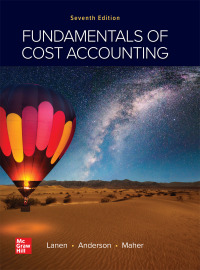Answered step by step
Verified Expert Solution
Question
1 Approved Answer
Can someone please help me answer this assignment? If you can provide explanations that'd be great! ( Please answer quickly ) Wallace Pharmaceuticals' original single
Can someone please help me answer this assignment? If you can provide explanations that'd be great! Please answer quickly
Wallace Pharmaceuticals' original single plantwide overhead allocation rate costing system allocated overhead costs to products at $ per machine hour. Compute the total overhead costs allocated to the commercial containers and to the travel packs under the original system. Then compute the overhead cost per unit for each product. Round to two decimal places.
Compute the predetermined overhead allocation rate for each activity.
Use the predetermined overhead allocation rates to compute the activitybased costs per unit of the commercial containers and the travel packs. Round to two decimal places. Hint: First compute the total activitybased costs allocated to each product line, and then compute the cost per unit.
Compare the overhead activitybased costs per unit to the overhead costs per unit from the traditional system. How have the unit costs changed? Explain why the costs changed.
Wallace Pharmaceuticals manufacturers an overthecounter allergy medication. The company sells both large commercial containers of capsules to health care facilities and travel packs of capsules to shops in airports, train stations, and hotels. The following information has been developed to determine if an activitybased costing system would be beneficial: View the information.
Read the requirements.
Requirement Wallace Pharmaceuticals' original single plantwide overhead allocation rate costing system allocated overhead costs to products at $ per machine hour. Compute the total overhead costs allocated to the commercial containers and to the travel packs under the original system. Then compute the overhead cost per unit for each product. Round to two decimal places.
Select the formula, and then enter the amounts to compute the indirect cost per unit for each product. Abbreviation used: manufacturing. Round dollar amounts to two decimal places.
Requirement Compute the predetermined overhead allocation rate for each activity.
Begin by selecting the formula to calculate the predetermined overhead allocation rate. Then enter the amounts to compute the allocation rate for each activity. Abbreviation used: qty quantity. Round your answers to the nearest whole dollar.
Requirement Use the predetermined overhead allocation rates to compute the activitybased costs per unit of the commercial containers and the travel packs. Round to two decimal places. Hint: First compute the total activitybased costs allocated to each product line, and then compute the cost per unit.
Begin by selecting the formula to allocate overhead costs.
Compute the total activitybased costs allocated to commercial containers, and then compute the cost per unit for commercial containers. Finally, compute the total activitybased costs allocated to travel packs then compute the cost per unit for travel packs. Round the cost per unit to two decimal places.
tableCommercial containersMaterials handling,PackagingQuality assurance,Total activitybased costs,Number of units,Activitybased cost per unit,
Requirement Compare the overhead activitybased costs per unit to the overhead costs per unit from the traditional system. How have the unit costs changed? Explain why the costs changed.
Relative to activitybased costing ABC the traditional system the commercial containers and the travel packs.
The traditional system allocates overhead costs solely on Activitybased costing ABC recognizes that although commercial containers require machine hours per unit than travel packs, they the same proportion of material handling and quality assurance.
Information
tableCost Pool,,tableEstimated TotalOverhead CostAllocation Base,tableEstimated TotalQuantity ofAllocation BaseMaterials handling,$ Number of kilos, kilosPackagingNumber of machine hours, hoursQuality assurance,,Number of samples, samplesTotal indirect costs,$
Actual production information includes the following:
tableCommercial Containers,Travel PacksUnits produced, containers, packsWeight in kilos,Machine hours,Number of samples,

Step by Step Solution
There are 3 Steps involved in it
Step: 1

Get Instant Access to Expert-Tailored Solutions
See step-by-step solutions with expert insights and AI powered tools for academic success
Step: 2

Step: 3

Ace Your Homework with AI
Get the answers you need in no time with our AI-driven, step-by-step assistance
Get Started


